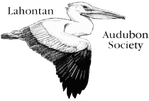|
By Parker Flickinger The Christmas Bird Count: for birders, this is a holiday tradition next to eggnog and hanging up stockings. I was surprised to learn that Lahontan Audubon Society has a long history with the Christmas Bird Count (CBC). Part of the reason our chapter was founded was to provide a means for CBC participants to stay connected and continue bird watching year-round. Before I came to work with Lahontan Audubon Society, I had only participated in Christmas Bird Counts as a bird counter. When I was offered the opportunity to lead an area on the Truckee Meadows Christmas Bird Count this year, I was excited and a bit nervous. I would soon find out that leading this year's count would be an exciting adventure which would provide me with new ideas and challenges and help me improve my skills both as a citizen scientist and a community organizer. The Christmas Bird Count is a community science project. With any community science effort, there is always the question of how much to focus on the “community” (people gathering together) versus the “science” (collecting accurate data). The “community” and “science” aspects are by no means mutually exclusive, however they are both important qualities of the bird count and should not be ignored. This year, I decided to take a mixed approach. On some of my walks, I would lead groups of birders as I do on field trips with Lahontan Audubon. On other walks, I would visit hotspots in my area by myself, as I had done during the Nevada Bird-a-thon. As is customary, I contacted our local CBC compiler before the count. I shared my ideas with them, and they gave me approval to move forward with my idea of a holistic CBC. The compiler gave me ideas about other hotspots to focus on and two goal species for my region: the rare Purple Finch and the Rock Wren. In addition to the compiler, I received another opportunity: eBird's Field Trip Report tool. The “Field Trip Report” tool would allow me to create checklists viewable to the general public. I was truly excited about this tool's potential for educating our community. The day of the Christmas Bird Count was a chilly morning, with icy snow on the ground. Our first stop was the May Arboretum at Rancho San Rafael Park. Six smiling birders trickled in to meet me, including a photographer who generously shared the photos you see. We traveled throughout the park, including the Arboretum, Herman's Pond, and Evans Creek. In between identifying birds, we all enjoyed sharing stories about our favorite birds and past adventures. Some of the highlights included an American Kestrel, Cooper's Hawk, Common Merganser, and Northern Mockingbirds, but no Purple Finch was found. After this adventure, I needed a lunch break at the Little Waldorf Diner. I next met with another birder in Lake Park. With its path and small pond, Lake Park offers solitude for whoever wishes to visit. For avian visitors, this includes Mallards, Canada Geese and House Sparrows. We observed all these species during our survey, plus a special surprise: a Spotted Towhee hiding inside a juniper tree. This was a reminder for us to keep our eyes open, as you can find birds in unexpected places. My first solo stop was Manzanita Lake at the University of Nevada Reno campus. This lake is known for its many waterfowl and songbirds. Here I observed Mountain Chickadees foraging in the brush and a flock of Common Goldeneyes diving down into the lake. I also discovered a Mute Swan gracefully paddling around the lake. I would later discover this was actually a captive bird, cared for by the university staff, therefore it was ineligible for our count. I would continue on to two other hotspots: Dick Taylor Memorial Park and Our Mother of Sorrows cemetery. These provided several bird species to the count, including Red-tailed Hawks, American Crows and an almost endless supply of Canada Geese. My last stop of the day was a neighborhood on Comstock Drive. The compiler had specifically suggested this hotspot for the count. One of the great joys I have when birding is seeing different species appear one after another. This was the case in the Comstock neighborhood. When I arrived, I was treated to a wonderful surprise. As if on cue, I was greeted by a “goal” bird, a Rock Wren cheerfully singing on a fence. As I watched the wren, I noticed some fluttering in the garden behind it, and saw a flock of California Quail. After logging these birds, I turned around and saw another American Kestrel landing on a telephone wire, followed by a flock of Mourning Doves. What a perfect ending to my CBC, having the birds “appear” for me like this. Although I had finished my day as a CBC leader, my work was far from over. I then had the job of carefully adding up all the species on our checklists. I enjoyed this process, and it ensured quality in our count results. From our data sheets and photographs, I was able to put together our first eBird Field Trip report. The report captured our adventure and can be easily shared with the CBC team and the general public. I am truly happy I was able to participate as a leader in this year's Truckee Meadows CBC. This enabled me to participate in a long-standing birding tradition and bring in other birders from our community. Complementing the tradition was finding new ways to share birding through digital media and public events. The Truckee Meadows count was able to excellently balance traditions, new collaborative ideas and camaraderie. I hope that the Truckee Meadows CBC can continue on as an ever-evolving birding tradition. Special thanks to:
|
topics
All
Archives
July 2024
|


 RSS Feed
RSS Feed